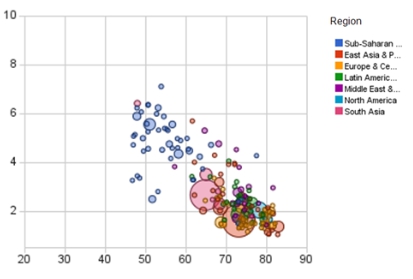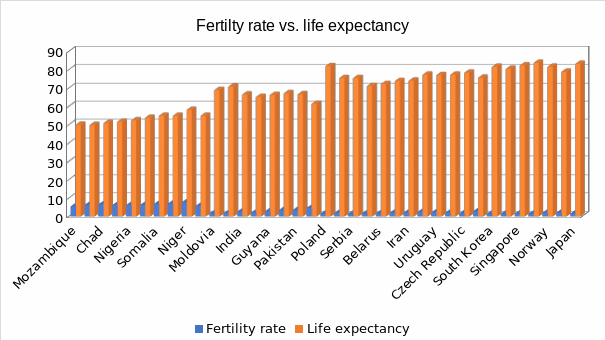Research question
An individual is likely to live for at least 80 years in a country where the maximum number of children per woman is two. However, an individual is likely to die before the age of 60 in a country where the number of children per woman is more than six.
Background
The research question is interesting because an increase in population has both positive and negative effects on economic growth and development. Most developed countries such as the US have already exceeded their bio-capacity. Thus, their natural resources will not be able to support production of adequate food and disposal of wastes if their populations continue to rise (Shaw, Horrace and Vogel 768-783).
However, low fertility rates in developed countries have already caused high labor costs, which threaten the sustainability of economic activities. Thus, the argument that a low fertility rate (maximum of two children per woman) leads to a long life expectancy is counterintuitive. Specifically, life expectancy will reduce if economic activities that produce the necessities of life become unsustainable due to the high labor costs that result from low fertility rates (Kabir 185-204).
Source of the Data
The dataset was downloaded from www.google.com/publicdata/. The dataset consisted of three variables namely, population size, life expectancy, and fertility rate. The data was collected from 200 countries in various parts of the world.
Hypothesis
Countries with high life expectancy (at least 80 years) prefer to have less than two children per woman. However, countries where the life expectancy at birth is less than 60 years prefer to have at least four children per woman.
Predictors
From the sample of 200 countries, life expectancy at birth is expected to increase as the number of children per woman reduces. Thus, people live longer in countries with low fertility rates than those with high fertility rates.
Analysis
The data was used to determine the correlation between fertility rate and life expectancy as shown in figure 1. The colored bubbles in figure 1 represent various countries. The size of each bubble was determined by the size of the population of the country that it represents. The data was also used to compare the fertility rate and life expectancy in select countries as shown in figure 2.
Findings
Figure 1 shows that an individual can only live for a maximum of 55 years in a country where the average number of children per woman is six. However, life expectancy increases to 82 years in countries where the maximum number of children per woman is two. According to the figure 1, majority of the countries with more than four children per woman had a life expectancy of 60 years. Figure 2 clearly shows that life expectancy is high in countries with low fertility rate and vice versa.
Conclusions
The findings indicate that an individual is likely to die before his or her 60th birthday in a country where women have at least six children in their lifetime. Moreover, an individual can live for at least 80 years in a country where women have very few children.
How the Data Supports the Findings/ Conclusions
The analysis shows that fertility rate has an inverse relationship with life expectancy in various countries. Specifically, the data indicates that life expectancy is increasing as the number of children per woman reduces. This means that it is possible to live for 80 years in a country with a low fertility rate. It also indicates that a person is likely to die before the age of 60 years in a country with a high fertility rate.


Works Cited
Kabir, Mahfuz. “Determinants of Life Expectancy in Developing Countries.” Journal of Developing Areas 41.2 (2008): 185-204. Print.
Shaw, James, William Horrace and Ronald Vogel. “The Determinants of Life Expectancy: An Analysis of OECD Health Data.” Southern Economic Journal 71.4 (2005 ): 768–783. Print.